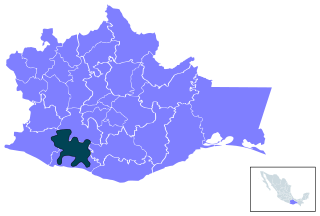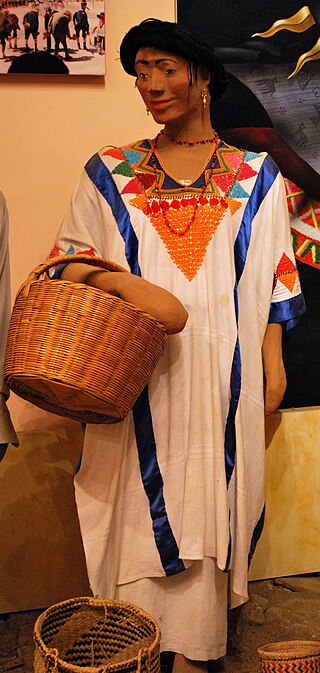
Mesoamerican languages are the languages indigenous to the Mesoamerican cultural area, which covers southern Mexico, all of Guatemala, Belize, El Salvador, and parts of Honduras, Nicaragua and Costa Rica. The area is characterized by extensive linguistic diversity containing several hundred different languages and seven major language families. Mesoamerica is also an area of high linguistic diffusion in that long-term interaction among speakers of different languages through several millennia has resulted in the convergence of certain linguistic traits across disparate language families. The Mesoamerican sprachbund is commonly referred to as the Mesoamerican Linguistic Area.

The Oto-Manguean or Otomanguean languages are a large family comprising several subfamilies of indigenous languages of the Americas. All of the Oto-Manguean languages that are now spoken are indigenous to Mexico, but the Manguean branch of the family, which is now extinct, was spoken as far south as Nicaragua and Costa Rica. Oto-Manguean is widely viewed as a proven language family.

The Zapotec languages are a group of around 50 closely related indigenous Mesoamerican languages that constitute a main branch of the Oto-Manguean language family and are spoken by the Zapotec people from the southwestern-central highlands of Mexico. A 2020 census reports nearly half a million speakers, with the majority inhabiting the state of Oaxaca. Zapotec-speaking communities are also found in the neighboring states of Puebla, Veracruz, and Guerrero. Labor migration has also brought a number of native Zapotec speakers to the United States, particularly in California and New Jersey. Most Zapotec-speaking communities are highly bilingual in Spanish.
The Zapotecan languages are a group of related Oto-Manguean languages which descend from the common proto-Zapotecan language spoken by the Zapotec people during the era of the dominance of Monte Albán.

The Zapotec civilization is an indigenous pre-Columbian civilization that flourished in the Valley of Oaxaca in Mesoamerica. Archaeological evidence shows that their culture originated at least 2,500 years ago. The Zapotec archaeological site at the ancient city of Monte Albán has monumental buildings, ball courts, tombs and grave goods, including finely worked gold jewelry. Monte Albán was one of the first major cities in Mesoamerica. It was the center of a Zapotec state that dominated much of the territory which today is known as the Mexican state of Oaxaca.

Chatino is a group of indigenous Mesoamerican languages. These languages are a branch of the Zapotecan family within the Oto-Manguean language family. They are natively spoken by 45,000 Chatino people, whose communities are located in the southern portion of the Mexican state of Oaxaca.
San Jacinto Tlacotepec is a town and municipality in Oaxaca in south-western Mexico. The municipality covers an area of 233.5 km². It is part of the Sola de Vega District in the Sierra Sur Region.
San Juan Lachao is a town and municipality in Oaxaca in south-western Mexico. It is part of the Juquila District in the center of the Costa Region.
San Juan Quiahije is a town and municipality in Oaxaca in south-western Mexico. It is part of the Juquila District in the centre of the Costa Region. The origin of the name Quiahije is not known, some people conjecture it might mean "Stone Forest" in the Zapotec language.
Tataltepec de Valdés is a town and municipality in Oaxaca in south-western Mexico. It is part of the Juquila District in the center of the Costa Region. The town was established around 400-300 BC. The name "Tataltepec" means "Grandfather hill". Antonio Valdés, born in the town, was an early leader of the independence movement in Oaxaca who died on 19 November 1811.
Santa Cruz Zenzontepec is a town and municipality in Oaxaca in south-western Mexico. It is part of the Sola de Vega District in the Sierra Sur Region.

Juquila District is located in the center of the Costa Region of the State of Oaxaca, Mexico, on the Pacific coast. It has an area of 5,055 km2. As of 2005 it had a total population of 134,365 of whom 33,106 spoke an indigenous language. Economic activities include agriculture and tourism. The Santuario (Sanctuary) de Juquila is a major attraction.

The Indigenous people of Oaxaca are descendants of the inhabitants of what is now the state of Oaxaca, Mexico, who were present before the Spanish invasion. Several cultures flourished in the ancient region of Oaxaca from as far back as 2000 BC, of whom the Zapotecs and Mixtecs were perhaps the most advanced, with complex social organization and sophisticated arts.

The state of Oaxaca, Mexico has a total population of about 3.5 million, with women outnumbering men by 150,000 and about 60% of the population under the age of 30. It is ranked tenth in population in the country. Fifty three percent of the population lives in rural areas. Most of the state’s population growth took place between 1980 and 1990. Life expectancy is 71.7 for men and 77.4 for women, just under the national average. Births far outpace deaths. In 2007, there were 122,579 births and 19,439 deaths. Approximately 85% profess the Catholic faith.
Tilquiapan Zapotec is an Oto-Manguean language of the Zapotecan branch, spoken in southern Oaxaca, Mexico.
Highland Chatino is an indigenous Mesoamerican language, one of the Chatino family of the Oto-Manguean languages. Dialects are rather diverse; neighboring dialects are about 80% mutually intelligible.
Tataltepec Chatino, also known as Lowland Chatino and Chatino Occidental Bajo, is an indigenous Mesoamerican language, one of the Chatino family of the Oto-Manguean languages. It is not intelligible with other Chatino languages. It is named after the town of Tataltepec de Valdés, and is also spoken in San Pedro Tututepec.
Zacatepec Chatino is an indigenous Mesoamerican language, a dialect of Eastern Chatino of the Oto-Manguean language family. It is often referred to as Chaqꟳ tinyaᴶ Kichenᴬ tziꟲ, Chatino de San Marcos Zacatepec, or Chatino de Zacatepec as it is distinct from other Eastern Chatino dialects in the region. Zacatepec Chatino is spoken in the town of San Marcos Zacatepec, a town of approximately 1,000 people and inhabited by the Chatino people. The language was once spoken in the village of Juquila, but is now virtually extinct there with only two surviving speakers in the area.
Zenzontepec Chatino, also known as Northern Chatino, or "Chatino Occidental Alto" is an indigenous Mesoamerican language, one of the Chatino family of the Oto-Manguean languages. It is not intelligible with other Chatino languages. It is spoken by one of the most isolated groups in Oaxaca, the Chatino people in the municipalities of Santa Cruz Zenzontepec and San Jacinto Tlacotepec, and in the former municipality of Santa María Tlapanalquiahuitl.
Emiliana Cruz is a contemporary linguistic anthropologist. She received her doctorate in linguistic anthropology from University of Texas at Austin and currently teaches at CIESAS-CDMX. She is the co-founder of the Chatino Language Documentation Project.








